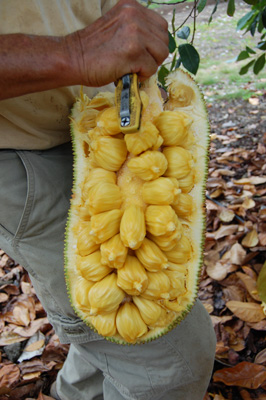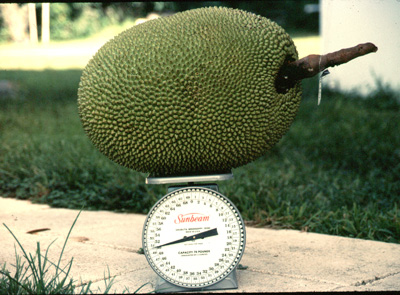Jackfruit (Artocarpus heterophyllus) is a tropical tree native to western India that has been cultivated in Florida for more than a century. But now, with superior varieties available and growing techniques updated, it’s time to take advantage of its potential for production.
Jackfruit makes a handsome tree with fruit weighing up to 70 pounds each. This can sound overwhelming — using a 70-pound fruit is a challenge. But some of the new varieties offer a more manageable size of 2 to 15 pounds.
Jackfruit development has been part of Fairchild’s Tropical Fruit Program since 1987. Working with the Florida Department of Agriculture and Consumer Services and the Tropical Fruit Growers of South Florida, we’ve focused our research on the introduction and evaluation of cultivars from tropical Asia and the distribution of superior cultivars for use in tropical America.
As a result, superior cultivars are now available. Modern propagation and growing techniques have been developed.

Noris Ledesma, curator of tropical fruit, with one of the new jackfruit cultivated at Fairchild.
Growing Jackfruit in South Florida
If you want to grow jackfruit at home, here’s what you need to know.
Because of its outer appearance, jackfruit is called “alligator fruit” in some parts of the world. The fruit grows from the tree trunk itself, and occasionally even from the surface roots of the tree.
What you’re looking for is fruit weighing 2 to 15 pounds, with a uniform shape and smooth skin. The flesh should be firm and crunchy, deep yellow or orange, with a light, non-musky flavor.
When fully ripe, the unopened jackfruit has a strong, sweet odor, and its ripe fleshy bulbs smell of sweet pineapple and banana. Inside the leathery exterior are starchy seeds surrounded by a sweet and aromatic flesh, with a distinctive flavor reminiscent of bananas and tutti-frutti..
There are many recipes for jackfruit, or you can simply eat it out of hand, raw.
In India jackfruit is often called “the meat fruit” because of its meaty texture when it is immature. It is common in many regions of India for the main course of a meal to be composed only of jackfruit. The fruit bulbs are used in soups, main dishes, desserts, milk drinks, ice cream and fruit salads. The fresh bulbs are excellent dried or preserved in syrup. After you invite your friends to share your sweet jackfruit, offer a meal of green jackfruit as a contrast to surprise them.
CULTIVATION
A graft should be used to ensure a healthy and productive tree. Jackfruit trees are best planted when the temperatures are warm. The planted tree should be thoroughly watered to remove air pockets. It won’t need supplemental irrigation after the tree is established. However, for those who tend to overwater, the jackfruit may be your answer, as it can withstand daily drenching with no ill effects.
Soil should be as fertile as possible and will benefit from the addition of mulch to the soil surface. Mulch will improve water-holding capacity, nutrient retention and availability and soil structure. Wind, when associated with low humidity, is detrimental to the health of young jackfruit trees. The tree is not tolerant of salt in the soil, water or air. Fertilization is best done by three applications per year in March, July and September of an 8-3-9 or other fruit tree formulation.
Jackfruit trees will form a stately, dense and rounded canopy with a minimum of input, but horticultural management is necessary to maintain a small, healthy and productive tree. With annual pruning the tree is easily maintained at a height and spread of six to eight feet. Pruning should be done once per year following harvest of the major crop, or towards the end of the growing season.

Inside the leathery exterior of the jackfruit are starchy seeds surrounded by a sweet, aromatic flesh. Noris Ledesma/FTBG.
Here are some jackfruit cultivars we have found suitable to South Florida:
• Fairchild First is one of the jackfruit varieties developed at Fairchild. The tree is upright and of medium vigor and can easily be maintained at a height of 10 feet or less with production of about 132 pounds of fruit per year. The fruit is small and smooth in comparison to other cultivars because the spines flatten and open as the fruit matures. During certain times of the year, the entire fruit can be eaten, including the “rag.” The flesh is firm and mild, with little latex.
• Sweet Fairchild was selected in Florida as a seedling of “Tabouey.” The tree is upright and vigorous in its growth but can be maintained at a height of 12 feet with annual pruning. Fruiting is heavy and consistent, averaging 200 pounds or more per year. The fruit are large, at an average size of 18 pounds. The flesh is a light yellow and is firm, with a mild, sweet flavor.
• Black Gold was selected in Queensland, Australia. This tree grows vigorously, with a dense and highly manageable canopy. With annual pruning the tree can be maintained at a height and spread of six to eight feet, with consistent, heavy production of 120 to 200 pounds per tree. The fruit are medium-sized, averaging 14 pounds. The exterior of the fruit is dark green and has sharp, fleshy spines. The spines do not flatten, or “open” upon maturity, making it difficult to judge the proper harvest time and maturity. However the deep orange flesh is soft, with a strong, sweet flavor and aroma. The flesh is easier to remove from the fruit than it is with other cultivars.
• Dang Rasimi originated in Thailand. The tree is open, spreading and fast growing. Dang Rasimi is one of the most vigorous jackfruit cultivars and must be pruned annually to maintain a height and spread of 10-12 feet. The trees are highly productive, yielding 165 to 275 pounds of fruit per tree, while maintaining vigorous growth. The fruit is bright green to pale yellow and uniform in shape if thinned to one fruit per fruiting spur. The skin has sharp spines that do not flatten or “open” with maturity. Fruit is medium to large, averaging about 18 pounds. The flesh is deep orange and firm. It has a mild, sweet flavor and a sweet, pleasant aroma.

The Dang Rasimi jackfruit originated in Thailand. Noris Ledesma/FTBG.
• Golden Nugget was selected in Queensland, Australia. The tree is fast growing, with a distinctive dark green, rounded leaf. It forms a dense, spreading canopy, which is easily maintained at a height and spread of six to eight feet. The fruit is small, green and rounded, with sharp, fleshy spines on the skin. The spines flatten to a smooth, golden-yellow upon maturity. The fruit weighs about seven pounds, with an excellent edible flesh. The deep orange flesh is soft to medium firm depending on fruit ripeness. The flavor is excellent and the flesh has no fiber. Golden Nugget fruit will often split open prior to ripening when there are heavy rains. Yields range from 130 to 175 pounds per tree per year.
• J-31 was selected in Malaysia. The tree is moderately vigorous, forming a spreading, open canopy. The tree can be maintained at a height and spread of six to eight feet. Trees of this size can produce 90 to 130 pounds per year. The fruit is large and irregular in shape with prominent, blunt spines, weighing about 25 pounds, with a deep yellow flesh. The flavor is sweet and rich with a strong, earthy aroma. J-31 will often produce off-season fruit during the fall and winter.
The jackfruit is an excellent tree for a home garden, for both form and function. Whether your garden is large or small, you can grow your own jackfruit. Come to Fairchild’s Jackfruit Festival on Saturday and learn all you need to know to grow your own tree.
Noris Ledesma is curator of tropical fruit at Fairchild Tropical Botanic Garden.
